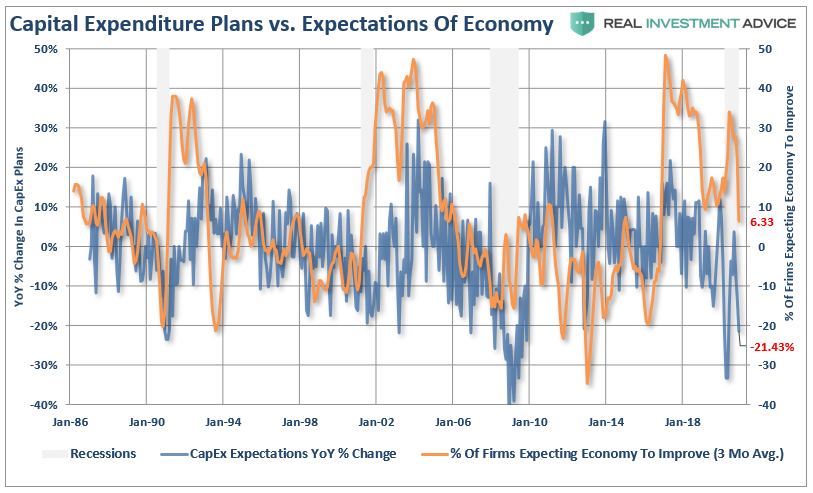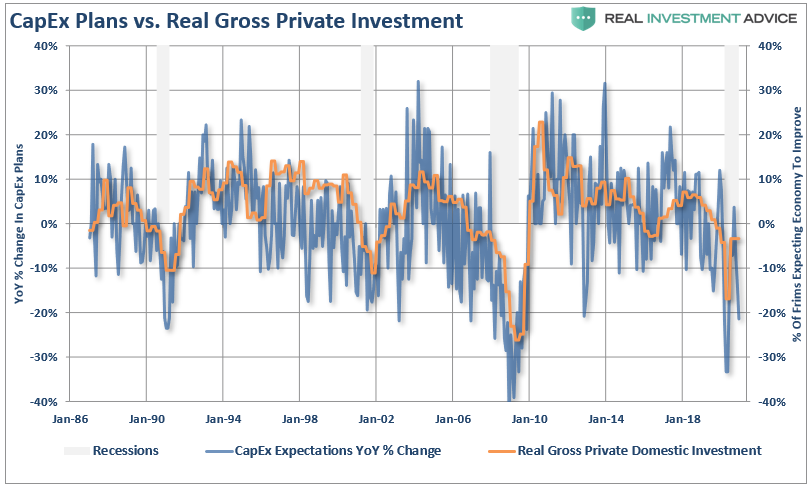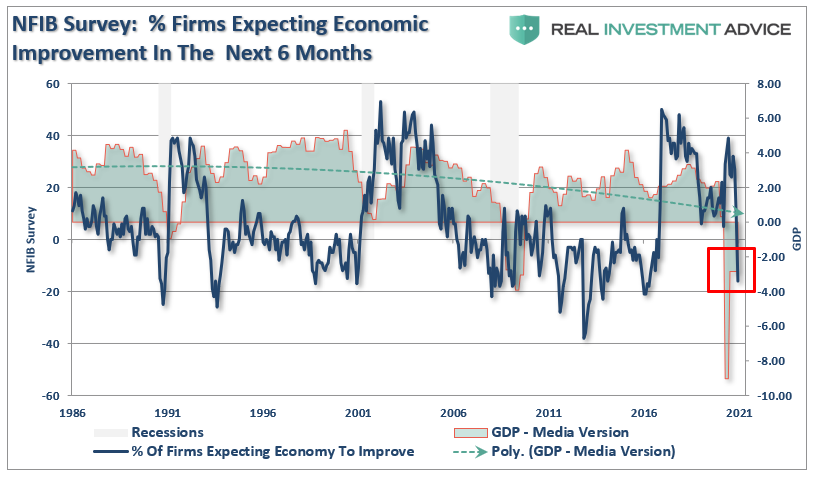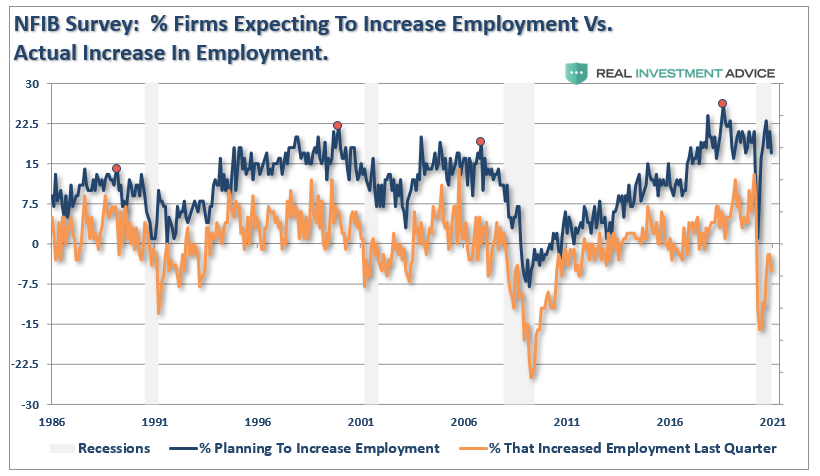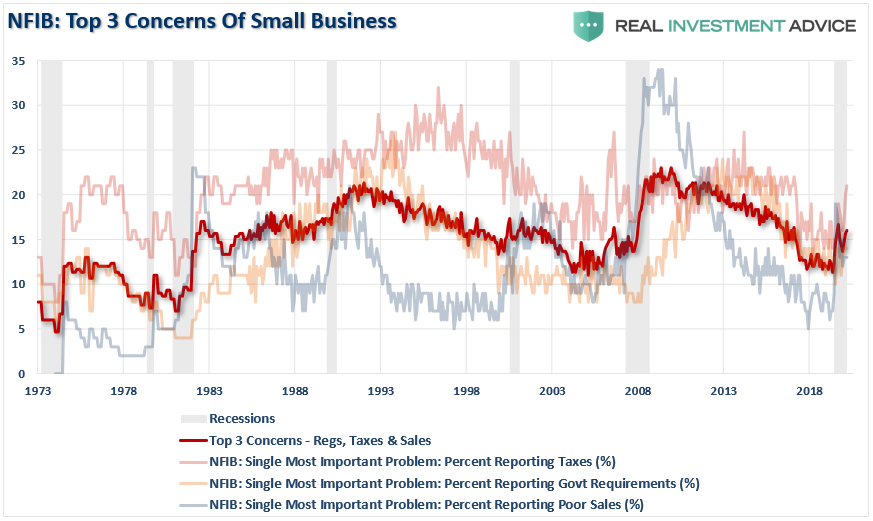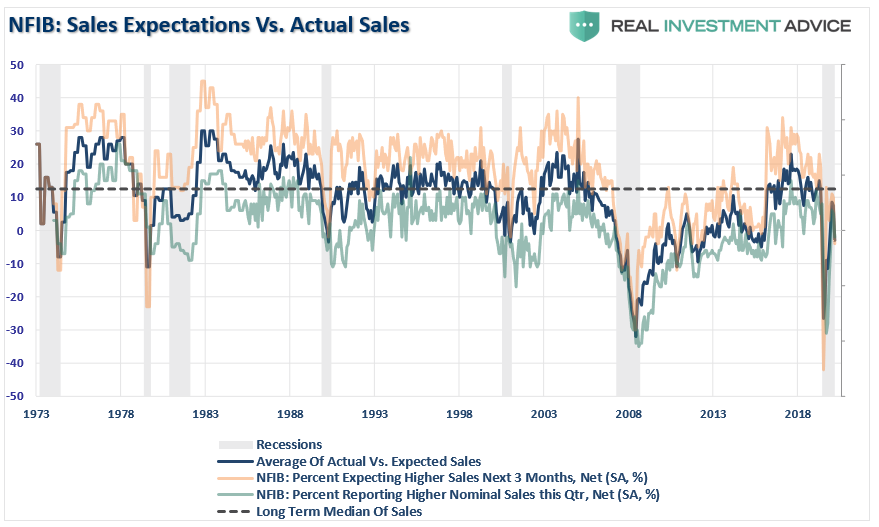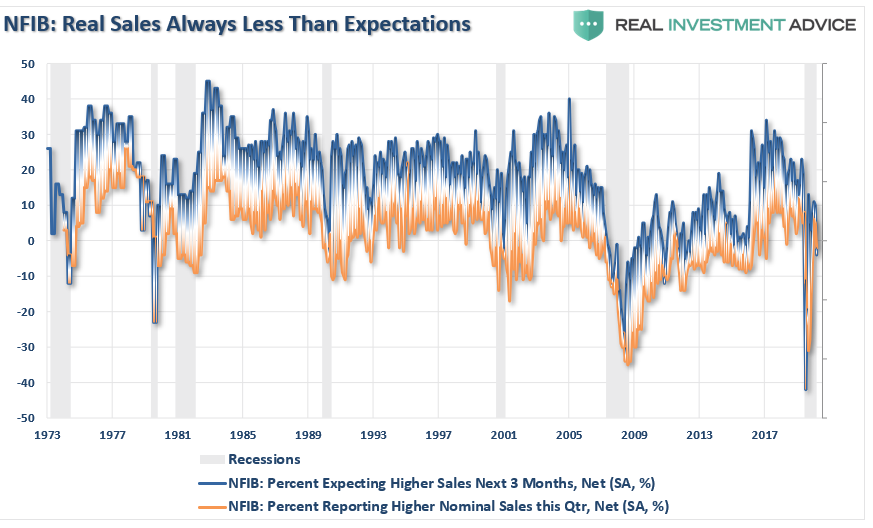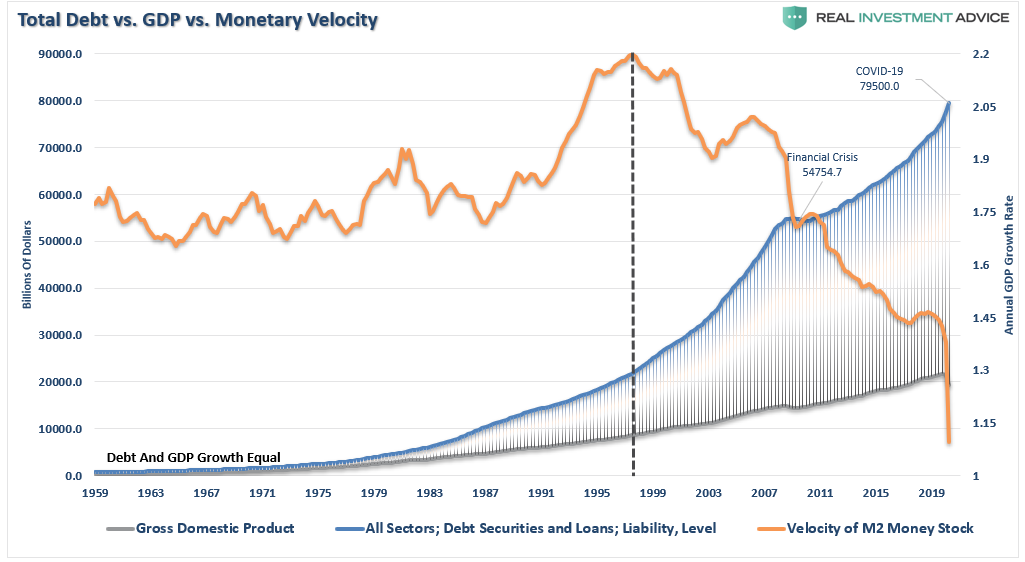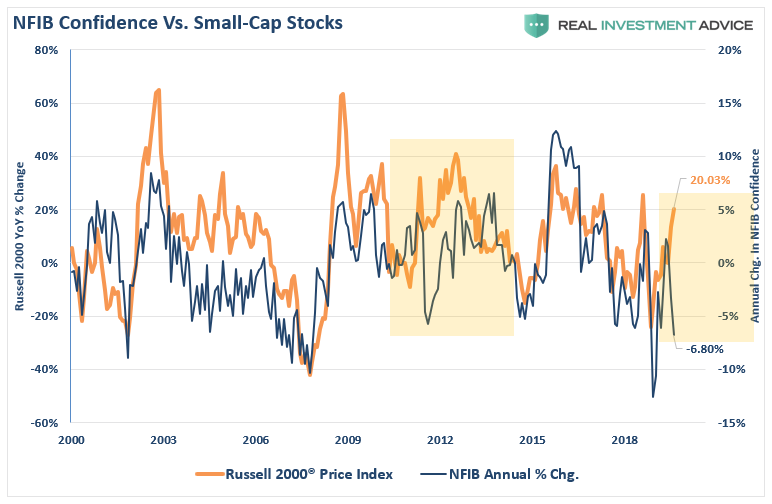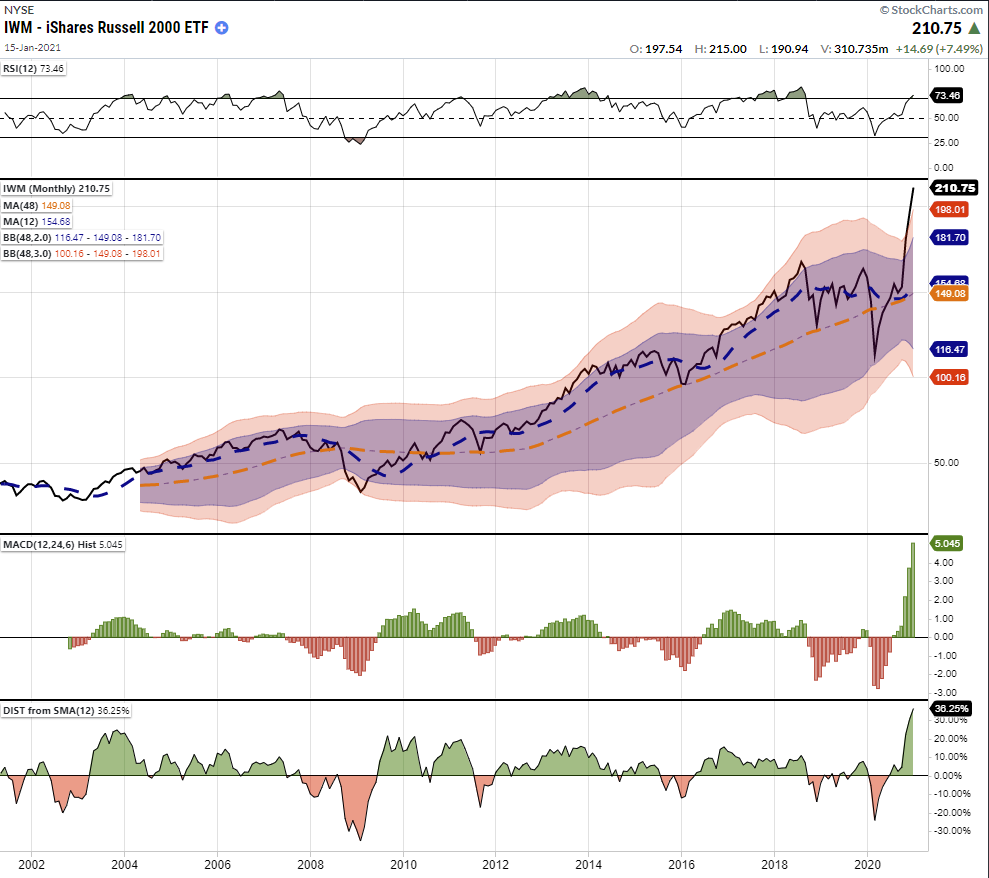In September 2019, I wrote “NFIB Survey Trips Economic Alarms,” Of course, it was just a few short months later the U.S. economy fell into the deepest recession since the “Great Depression.” The latest NFIB survey is sending a strong warning to investors piling into small-cap stocks.
While the mainstream media overlooks the NFIB data, they really shouldn’t. There are currently 30.7 million small businesses in the United States. Small businesses (defined as fewer than 500 employees) account for 99% of all enterprises, employ 60 million people, and account for nearly 70% of employment. The chart below shows the breakdown of firms and jobs from the 2019 Census Bureau Data.
Despite all the headlines about Microsoft (NASDAQ:MSFT), Apple (NASDAQ:AAPL), Tesla (NASDAQ:TSLA), and others, small businesses drive the economy, employment, and wages. Therefore, what the NFIB says is relevant to what happens in the economy.
NFIB Shows Confidence Drop
In December, the survey declined to 95.9 from a peak of 108.8. Notably, many suggest the drop was “politically driven” by conservative owned businesses. While there was indeed a drop following the election, the decline continues what started in 2018.
As I discussed when the index hit its record high previously:
“Record levels of anything are records for a reason. It is the point where the sustainability of activity can not be increased further. Therefore, when a ‘record level’ is reached, it is NOT THE BEGINNING, but rather an indication of the MATURITY, of a cycle.”
That point of “exuberance” was the peak of the economy.
Before we dig into the details, let me remind you this is a “sentiment” based survey. Such is a crucial concept to understand as “Planning” to do something is a far different factor than actually “doing” it.
An Economic Boom Will Require Participation
Currently, many analysts expect a massive economic boom in 2021. The basis of those expectations is massive “pent-up” demand when the economy reopens.
I would agree with that expectation had there been no stimulus programs or expanded unemployment benefits. Those inflows allowed individuals to spend during a recession where such would not usually be the case. Those artificial inputs dragged forward future or “pent-up” consumption into the present.
However, the NFIB survey also suggests much the same.
Small businesses are susceptible to economic downturns and don’t have access to public markets for debt or secondary offerings. As such, they tend to focus heavily on operating efficiencies and profitability.
If businesses were expecting a massive surge in “pent up” demand, they would be doing several things to prepare for it. Such includes planning to increase capital expenditures to meet expected demand. Unfortunately, those expectations peaked in 2018 and are lower again.
There are important implications to the economy since “business investment” is a GDP calculation component. Small business capital expenditure “plans” have a high correlation with real gross private investment. The plunge in “CapEx” expectations suggests business investment will drop sharply next month.
As stated, “expectations” are very fragile, and reality is often quite different.
Employment To Remain Weak
If small businesses think the economy is “actually” improving over the longer term, they would also be increasing employment. Given business owners are always optimistic, over-estimating hiring plans is not surprising. However, reality occurs when actual “demand” meets its operating cash flows.
To increase employment, which is the single most considerable cost to any business, you need two things:
- Confidence the economy is going to continue to grow in the future, which leads to;
- Increased production of goods or services to meet growing demand.
Currently, there is little expectation for a strongly recovering economy. Such is the requirement for increasing employment and expanding capital expenditures.
Now you can understand the biggest problem with artificial stimulus.
Yes, injecting stimulus into the economy will provide a short-term increase in demand for goods and services. When the funds are exhausted, the demand fades. However, small business owners understand the limited impact of artificial inputs. As such, they will not make long-term hiring decisions, an ongoing cost, against a short-term artificial increase in demand.
Also, given President Biden is focused on more government regulation and higher taxes (which falls squarely on the creators of employment), increased costs will further deter long-term hiring plans.
The Big Hit Is Coming
Retail sales make up about 40% of personal consumption expenditures (PCE), which comprises roughly 70% of the GDP calculation. Each month the NFIB tracks both actual sales over the last quarter and expected sales over the next quarter. There is always a significant divergence between expectations and reality.
While stimulus may lead to a short-term boost in consumption, the impact of higher taxes, more regulations, and weak employment growth will suppress consumption longer-term.
The weakness in actual sales explains why employers are slow to hire and commit capital for expansions. As noted, employees are among the highest costs associated with any enterprise, and “capital expenditures” must pay for themselves over time. The actual underlying strength of the economy, despite cheap capital, does not foster the confidence to make long-term financial commitments to anything other than automation.
Despite mainstream hopes, business owners must deal with actual sales at levels more commonly associated with ongoing recessions rather than recoveries.
Of course, this remains an argument of ours over the last couple of years. While the media keeps touting the strength of the US consumer, the reality is quite different. If such were indeed the case, there would be no requirement to inject billions of dollars in stimulus to keep individuals afloat.
So what does all this have to do with small-caps?
Small Caps May Disappoint
With this background, it is easier to understand why the recent exuberance in chasing small cap may be premature. While small-cap companies do historically perform well coming out of recession, the basis was an organic recovery cycle of increasing productivity.
Currently, the run-up remains the assumption that the stimulus-fueled recovery is sustainable. Such is only the case if the stimulus becomes a regular benefit and increases in size annually. However, since deficit-based spending is deflationary, the outcome will fall well short of expectations.
“in 1998, the Federal Reserve “crossed the ‘Rubicon,’ whereby lowering interest rates failed to stimulate economic growth or inflation as the ‘debt burden’ detracted from it. When compared to the total debt of the economy, monetary velocity shows the problem facing the Fed.”
Such is a critical point as it relates to small-cap companies given their high correlation to small-business confidence. There has only been one other period in history that small-caps detached from underlying confidence, and the outcome for investors was not good.
Given that investors continue to push the small-cap index to historical deviations from long-term means, the risk of disappointment is extremely high. Given the data above, it is unlikely the economic recovery will be nearly strong enough to justify the prices individuals currently pay for small-cap companies.
Furthermore, small-cap companies’ valuations on a 2-year forward estimate all but guarantee a poor outcome for investors in the future.
Conclusion
Given that debt-driven government spending programs have a dismal history of providing the economic growth promised, disappointment over the next year is almost a guarantee.
However, suppose additional amounts of short-term stimulus deliver higher rates of inflation and higher interest rates. In that case, the Federal Reserve may become contained in its ability to continue to provide an “insurance policy” to investors.
There are risks to assuming a strong economic and employment recovery over the next couple of quarters. The damage from the shut-down on the economy, and most importantly, small business, suggests recovery may remain elusive.
While there is nothing wrong with being optimistic, when it comes to your investment portfolio, keeping a realistic perspective on the data will be essential to navigating the risks to come. For small-cap investors, the time to take profits and move to “safer pastures” has likely arrived.



